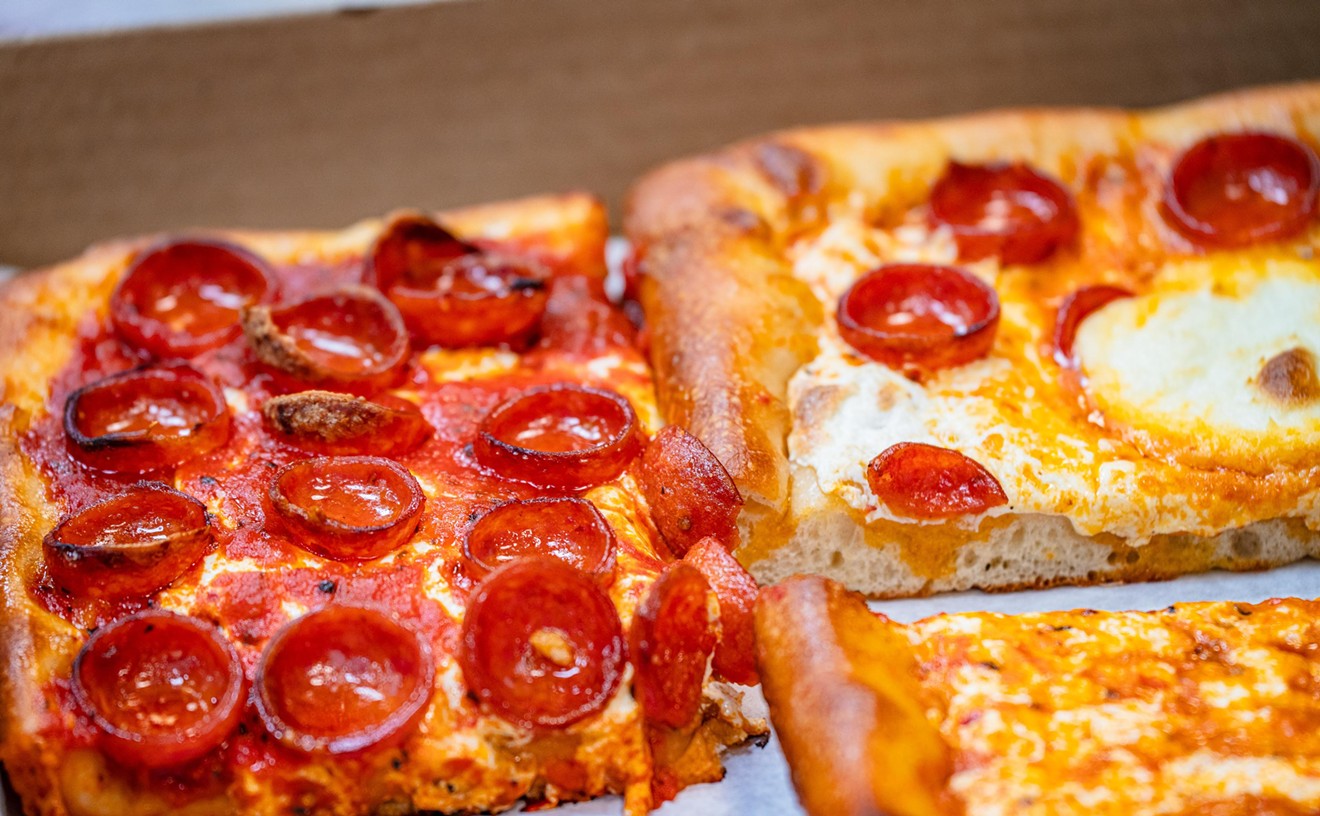Japanese food, particularly sushi, illustrates this theory perfectly. Although teriyaki, sukiyaki, and yakitori have come to represent generic Japanese-American fare in much the same way that chow mein and egg foo yung used to define Chinese-American food, from the start sushi bars never have pulled any culinary punches. Americans were introduced to quail eggs and sea urchin right alongside the arguably more palatable raw tuna and salmon. And when certain types of fish and seafood proved unobtainable -- sea bream, for instance, or whitebait -- reasonable substitutions were made. Here in South Florida, we dine on readily available conch, dolphin, and the freshest snapper.
The successful traverse of these first two steps alone would have ensured sushi a lasting niche in the Miami restaurant market. But right now the cuisine is experiencing tremendous growth in the last stage -- innovation -- thanks to the imaginative restaurateurs and chefs at Sunrice, Maiko, Sushi Rock Cafe, and Sushi Hana, who have started a sushi-roll revolution using fillings such as deep-fried soft-shell crab, shrimp tempura, broccoli, spinach, and even cooked chicken. Friends who visit from other parts of the U.S., including those from New York and California, are astonished by (and envious of) the tradition-bending variety of Miami sushi.
Now, Taka Furuya, chef-owner of the year-old Katana Japanese Restaurant, located on 71st Street, has added another dimension to the city's Japanese restaurant scene. Like chefs at other area sushi eateries, Furuya serves his ngiri ("fingers" of rice topped with fish) and makimono (multi-ingredient rolls sliced into pieces) on "boats" carved from bamboo and other light woods; but unlike the boats at, say, Sushi Rock Cafe, Furuya's vessels literally float.
The restaurant's tables, which accommodate 28 seats total, are arranged around a moatlike counter. Propelled by a water pump, boats ferrying tempting little morsels (or, more precisely, pairs of morsels) parade past diners. You simply remove the cargo that tempts you. In the center "island," Furuya watches the procession, cutting fish and shaping rice to replenish unloaded boats. The staff delivers hot appetizers and refills drinks by reaching across the water to hand customers plates and glasses, and even to clear the table; at one point while we were eating, our server requested that we hand him plate lids and bottle caps lying on the counter. We thought he might be keeping track of our order this way, but at the end of the meal, he tallied up our bill dim sumlike, according to the size and decorative pattern of the empty plates (prices range from $1.25 to $3.90) stacked in front of us.
Commonplace in Japan, here the boats are both novel and fun, with the sushi becoming, to borrow a phrase from Hemingway, "a moveable feast." But several drawbacks exist with this setup, starting with the very obvious problem some of us have with eye-hand coordination. One thing I learned fast on a recent visit to the restaurant: Raw fish can't swim. And while a certain amount of anticipation exists -- you never know what's coming around the bend next -- you spend so much time clocking sushi prospects, you barely can spare a glance at your companions.
At Katana, all portions are appetizer-size, a holdover from the days when the Japanese considered sushi a late-afternoon or evening snack rather than a meal. Our ngiri were served in two pieces per order, allowing us to sample a variety, including ebi (boiled, filleted shrimp noticeably sharpened with wasabi) and some vividly fresh tuna. We particularly enjoyed lacy salmon layered over vinegared rice, with a tiny dollop of cream cheese and chopped white onions lending a Noo Yawk deli appeal without overwhelming the fish. But robust American appetites can reduce a party of four to frenzied grabbing, resulting in a table crammed with plates and plate covers, with no one quite sure who's eating what.
Another problem: When the place is less than crowded, the sushi stays in rotation long enough for you to question its freshness. (Furuya throws away still-floating food after business hours, starting anew each evening -- the restaurant opens only for dinner.) Accordingly, we were disappointed by the eel, which was fatty and cold from its trip down (or around and around) the river. Likewise, a tempura roll (batter-fried vegetables wrapped in seaweed and rice), while crunchy and sweet, was a little flat-tasting at room temperature.
Sushi rolls, served in four pieces (except for the tempura roll, dished out in pairs), lacked the imagination Miamians have come to expect from the region's sushi chefs. While a standard California roll was tasty enough and sufficiently creamy from the avocado, I've never been fond of that fake crabstick stuff used to make one. A vegetable roll was a mere coupling of shredded carrot and cucumber -- pleasant, if not powerful. (A better veggie bet is a salad served with pungent carrot-ginger dressing, or a warming bowl of miso soup, afloat with seaweed.) Two variations on the California roll A one made with shrimp, crabstick, and avocado, the other with cooked chicken, crabstick, and avocado -- elicited the most appreciation.
One of my guests, not a huge raw-fish fan, was hard put to make a meal from the hot offerings, which can be ordered by filling in a preprinted card. We tried one of practically everything available, it seemed; the appetizers were delivered singly, as they were ready, making it difficult to distinguish between the chicken yakitori and the chicken teriyaki. Both boasted tender nuggets coated with the same dark, sweetish sauce, although in the case of the yakitori, the chicken was threaded on skewers.
Two plates of gyoza (dumplings) were also nearly identical twins, even though we ordered one version steamed and the other pan-fried (the steamed version was pan-fried on one side). Stuffed with minced meat and scallions, the eight gyoza (four per serving) were well-seasoned, the dough almost flaky. But we were suspicious of their uniformity. "Do you make them here?" we asked. "Oh, no," the waiter replied. "We buy them frozen."
Frozen appetizers aren't a big issue if they're good. Broiled calamari, obviously machine-cut, were horribly rank. Even the sweet yakitori sauce couldn't mask the taste. We sent it back. We also returned a dish of asparagus wrapped in bacon; we didn't need to ask if the asparagus had been frozen -- it still was. Cold, greasy bacon, more like fatback than crisp cured pork, had been coiled around half-thawed, watery asparagus stalks. All but one of us who had popped the bite-size pieces into our mouths had no choice but to chew and swallow; as for the exception, she opted to remove hers before it was too late, placing it on the side of her plate. Okay, gross enough. Sicker, though, was the server who, unnerved by our temerity of sending back two dishes in a row, suggested my friend place her serving back on the dish for reheating. Waste not, want not, I guess. Our verdict: just plain want not.
Vegetable croquettes were another prefab, quick-freeze item. Two deep-fried patties, resembling McDonald's breakfast hash browns and tasting like oniony latkes, were presented crisp and hot. However, I would have enjoyed these more as late-night munchies, prepared in my toaster oven at home A not for $1.45 each in Katana. That money's better spent on sushi, more reasonable here than at many other Japanese restaurants in Miami. In fact, a steady stream of sushi might be just the thing for a light meal. But if you're looking for the new, elaborate sushi rolls that currently dominate the scene, or a cooked meal worthy of more than the freezer and deep-fryer, forget about Katana -- floating boats or no floating boats, it's a wash.









